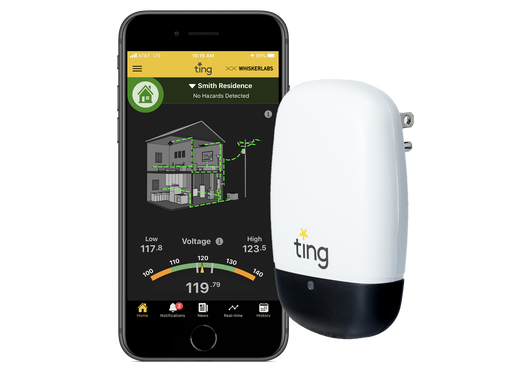IoT Sensor Network Catches Electrical Fires Early, Offers Wildfire Detection
Whisker Labs’ CEO Bob Marshall speaks about the dangers of an unstable grid and how IoT can be harnessed to fight it

Every year there are thousands of electrical fires in the U.S., representing billions of dollars in losses and impacting thousands of lives. One company is building a network of sensors to catch these electrical fires early and provide a level of insight into grid resilience that hasn't previously been seen.
Whisker Labs created a smart sensor, dubbed Ting, that plugs into a domestic outlet and monitors appliances’ wiring, detecting loose connections and damaged wires that can spark and cause a fire.
While initially operating on a household level, the growing number of these sensors means Whisker is creating an increasingly intricate network of grid monitors, which can provide new levels of data on where faults are happening, and how utilities can mitigate potential issues.
“What’s unique about our system is that while one sensor monitors the electrical grid inside the home, a network of these sensors allows us to monitor the entire grid with a precision and accuracy that’s never been seen before,” said Bob Marshall, Whisker Labs’ CEO.
“While the sensor looks very simple, it actually takes 30 million measurements every second. This data is streamed to the cloud and then we run machine learning and AI on it to identify potential issues. All this data together provides an in-depth documentation of grid resilience like nobody has done before.”

Credit: Whisker Labs
The Need for Grid-Wide Monitoring
Grid resilience is crucial at the best of times, and with homes becoming increasingly connected our reliance on secure power is greater than ever before.
However, as nations begin to shift toward clean energy and add new power sources to existing infrastructure, grids are becoming increasingly stressed and the potential for electrical fires is rising, with utilities not yet having enough data on grid faults to adapt to the changing landscape of stressors.
“There's growing evidence that the grid is getting increasingly stressed as we add solar and wind energy, and as we shift towards EV’s and battery technologies,” said Marshall. “The grid also has to be resilient to weather and climate conditions – whether it's cold or hot, windy or wet, whatever the case may be the grid has to handle it to deliver safe and reliable power. And the consequences can be catastrophic if it’s not.”
“We knew this kind of sensor network would be invaluable for utilities, but we didn’t know we’d find the things we're finding,” said Marshall. “One percent of U.S. homes have dangerous power going into them – power that can damage or destroy devices in the home and start a fire. These are not things utilities are aware of until we let them know.”
For now, the Ting sensor network can provide insight into when and where issues arise, which could be indicative of a range of factors including power lines touching each other, tree limbs touching wires or equipment becoming overheated. All of these things are factors not currently being monitored by utilities.
“What causes a lot of the damage and fires is power surges and low voltage and high voltage and that happens when, when you know what tree limbs touch power lines or power lines touch each other,” said Marshall. “And that's the kind of stuff that is not known by utilities unless we tell them.”
The only thing the sensor can’t yet do is identify which event caused specific faults. However, Marshall said this is the next step.
“There are certain areas that have more problems than others, but we don’t currently know what the specific physical causes of those problems are,” said Marshall. “Using IoT our network becomes a learning system, so once we have identified what certain issues look like, we can more easily identify them in the future.”
Wildfire Control
A significant use case for this network is also in wildfire detection and control. A large proportion of wildfires begin due to sparking from the grid and giving utilities real-time insight into when and where grid stress is building up could shift wildfire response from reactive to predictive.
Currently, Whisker Labs is working to establish partnerships with utilities so they can begin accessing and leveraging grid data, as well as grow its network of sensors to improve data accuracy.
“Utilities at the moment don’t have sophisticated IoT sensors on the grid,” said Marshall. “We’re looking to change that, and I'm a firm believer that we're creating the world's most valuable IoT sensor network.
“This network is scaling rapidly. We have around 350,000 sensors in the U.S. now and we're deploying 40,000 new homes per month. We expect to have millions of sensors connected in the next 12 to 18 months in the U.S., and all of this has huge opportunities for data insight.”
With the information on grid faults set to rise with the increased deployment of Whisker Lab’s Ting sensors, Marshall said there is “no doubt” utilities will be able to predict and prevent problems, responding to fires both within and outside of the home.
“To be clear, there is not currently a product that could have predicted the recent wildfires we saw in the U.S. and Hawaii,” said Marshall. “But looking retrospectively at the data, it's clear that we can produce a product that will allow utilities to know when their grid is becoming stressed, and they can make decisions to avoid disasters, like de-energizing the grid before it can start a fire.
“The idea of using IoT sensors to predict and prevent catastrophic events is like the Holy Grail of IoT sensors. You're using IoT and machine learning or artificial intelligence to understand, predict and prevent problems. And that's much better than reacting and replacing assets after a catastrophic failure.”
About the Author(s)
You May Also Like



.png?width=700&auto=webp&quality=80&disable=upscale)
.png?width=700&auto=webp&quality=80&disable=upscale)
.png?width=300&auto=webp&quality=80&disable=upscale)
.png?width=300&auto=webp&quality=80&disable=upscale)
.png?width=300&auto=webp&quality=80&disable=upscale)
